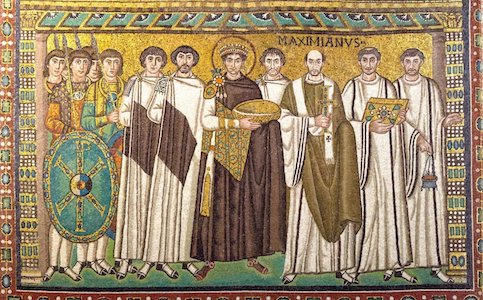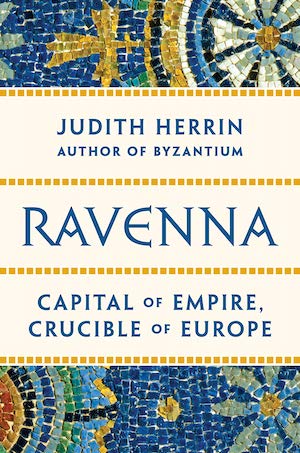By Allen D. Boyer
Fittingly, Judith Herrin’s history of Ravenna is a brilliant mosaic masterpiece. In a narrative that sweeps from the last years of the Roman Republic to the founding years of the Holy Roman Empire, this book unfolds the politics and religion behind the magnificent art that endures in a small, venerable Italian city.
Ravenna was founded by Julius Caesar, who planned it as a harbor for his fleet. The city came into its own five centuries later. It became a forward base—first for defending the Po Valley against barbarians, later as a western strongpoint for Byzantine forces. Flanked by marshes, it was hard to besiege, and its harbor offered easy communication with the rest of the Mediterranean.
As other Italian cities dwindled, Ravenna grew. While Rome became defined by the papacy, Ravenna preserved the imperial heritage. The city weathered the upheavals of its age. Or perhaps, to follow Henri Pirenne rather than Edward Gibbon, the upheavals were actually transitions. Theoderic, the Ostrogothic king reared in Constantinople, had a counterpart in Flavius Aetius, the gifted Roman commander who had spent his youth among the Goths and Huns.
The churches of Ravenna are reminders that the barbarians who sacked Rome were Christians—Arian believers, adherents to doctrine that the Church of Rome called heresy. The churches and their art represent religious and imperial controversies.
To match Ravenna’s early monuments of Roman Catholicism, the basilica of San Giovanni Evangelista and Bishop Neon’s Orthodox Baptistery, Theoderic built the Arian Baptistery. To overshadow Theoderic’s Church of Christ the Savior, Justinian built San Vitale—and when Catholicism defeated Arianism, the Church of Christ the Savior became San Apollinaire Nuovo. Artisans blanked out the mural likenesses of Theoderic and his Arian counselors with a new section of resplendent golden tiles.
And as for Galla Placidia, the earliest of Ravenna’s great patrons—the late-Roman princess who built the sumptuous oratory remembered as her mausoleum—for this nobilissima puella and augusta, Herrin magisterially narrates a biography of twists and tumults. Galla Placidia was the daughter of one emperor, consort to a second, mother to a third. By a brief first marriage, she was Queen of the Visigoths. She wielded power in Ravenna for decades, while emperors rose and fell: endowing churches, minting elegant gold coins, traveling with her bodyguard of bad-tempered Goths, embarrassed when her daughter proposed marriage to Attila the Hun.
Throughout this history, Herrin notes the changes and evolutions of city life. On the eastern horizon, war flares eternally, but with different foes: Persian emperors are replaced by Moslem caliphs. In city records, citizens no longer identify themselves with traditional Roman family names; they use their baptismal names and professions. Scribes cease to date documents by emperors’ regnal years; they speak of anno domini.
From Ravenna, Mediterranean learning made its way north and west: Gothic testaments, medical treatises, works on cosmography. Orators traveled to new capitals to make careers. So too (very probably) did architects and contractors, men who knew how to work marble and raise columns.

In San Vitale, the mosaic portraits of Justinian and Theodora, flanked by their retinues, have made the emperor and empress the best-known figures from Byzantine history. But it would be on Western Europe that these images had their greatest influence. Charlemagne visited Ravenna three times. The Frankish king was struck by San Vitale:
“Here for the first time, Charles gazed upon the defining images of imperial glory: the great sixth-century emperor, wearing the imperial regalia, the crown set with precious stones and pearl pendants, the purple cloak fastened with an enormous jeweled clasp at the shoulder, a glistening tablion of golden silk decorated with birds in green encircled in red, and brilliantly decorated shoes, an unforgettable image . . . . In the pose of Justinian, Charles saw a role, a title and an imperial model.”
Clearly written, deeply researched, richly illustrated, this book is the work of a lifetime. Herrin, a renowned scholar of Byzantium, first visited Ravenna as a teenager. She writes eloquently of the art and the life behind it. For it was in Ravenna, she argues, that the foundations of western Christendom were laid—where “rulers, exarchs and bishops, scholars, doctors, lawyers, mosaicists and traders, Roman and Goth, later Greek and Lombard, forged the first European city.”
Allen D. Boyer (ΦBK, Vanderbilt University, 1977) is a lawyer and historian, at work on a history of the law of treason in England. Vanderbilt University is home to the Alpha of Tennessee Chapter of Phi Beta Kappa.




